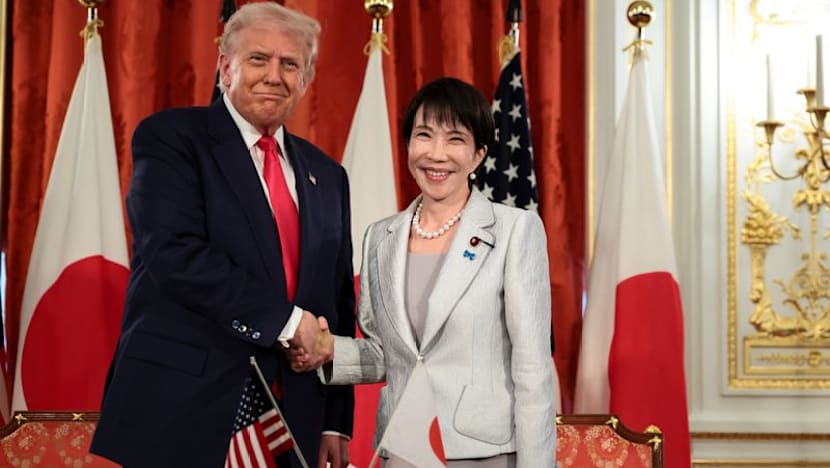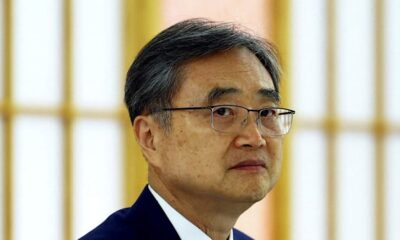World
Japan’s First Female Prime Minister Revives Abenomics with New Focus

On October 21, 2023, Sanae Takaichi was elected as Japan’s first female prime minister, marking a significant political milestone for the nation. A hardline conservative and protégé of the late former Prime Minister Shinzo Abe, Takaichi is poised to reinvigorate the country’s economic policies with a renewed emphasis on national security and regional influence.
Takaichi has made no secret of her hawkish stance on China and her determination to strengthen Japan’s defense capabilities. Her election comes as Donald Trump, former President of the United States, recently visited Japan, during which he praised Abe as “one of my favourites.” The timing of Takaichi’s leadership and Trump’s visit suggests potential for a strategic partnership, particularly in light of a trade deal signed in July. Under this agreement, Tokyo committed to investing USD 550 billion in the United States in exchange for reduced tariffs on Japanese goods. Takaichi aims to ensure that these investments also benefit Japanese companies.
Takaichi’s leadership campaign centers on reviving and adapting Abenomics, the economic strategy initiated by Abe in late 2012 to combat stagnation and counter China’s growing influence. This approach, characterized by a combination of monetary easing, fiscal stimulus, and structural reforms, is often referred to as the “three arrows” of Abenomics. The first arrow involved aggressive monetary policies by Japan’s central bank, which included low and negative interest rates to encourage borrowing and spending. Additionally, the Bank of Japan purchased significant amounts of financial assets to stimulate the economy.
The second arrow focused on increased government spending, particularly on infrastructure projects and tax incentives for businesses. The third arrow sought to reform the labor market and improve corporate governance, along with increasing women’s participation in the workforce. While Abenomics initially yielded positive results, such as a drop in unemployment from 4% in early 2012 to 3.7% in 2013, it also led to challenges, including rising public debt and a devaluation of the yen. Critics have noted that Abenomics failed to invigorate domestic investment sufficiently, as corporate leaders remained cautious about Japan’s long-term economic prospects.
Takaichi’s new vision, dubbed Sanaenomics, retains elements from Abenomics but shifts the focus towards expansionary fiscal policy and large-scale investments. Currently, Japan’s inflation rate is around 2.7%, a substantial increase compared to the low rates during Abe’s tenure. This context complicates the implementation of loose monetary policy, which Takaichi may navigate by prioritizing government investment in sectors deemed critical for national security, such as food, energy, and defence.
The US Treasury Secretary Scott Bessent recently expressed support for Takaichi’s approach, particularly her emphasis on “crisis management” investments. These investments are intended to reduce Japan’s dependence on foreign resources while bolstering strategic industries like semiconductors and electric vehicle batteries. Despite the ambitious nature of her economic programme, a pressing concern remains whether public spending can effectively stimulate private sector investment, given Japan’s history of corporate risk aversion.
To catalyse growth akin to the rapid expansion seen from the 1950s to the 1970s, Takaichi may need to foster collaboration between the public and private sectors. Historically, successful partnerships have allowed the government to share risks, making large projects more appealing for investment. The question now is whether Japan’s corporations, currently holding substantial cash reserves, will commit to domestic projects under Takaichi’s leadership.
There are inherent risks associated with Sanaenomics. Increased government spending could exacerbate Japan’s already high public debt, which credit rating agencies currently view as stable. Yet, concerns may arise if investors perceive a deterioration in the nation’s fiscal health. Moreover, Takaichi’s nationalist policies may strain relations with China, Japan’s largest trading partner. By framing China as a strategic threat and advocating for supply chains that bypass the country, Takaichi risks further economic friction. Additionally, her pledge to boost Japan’s defense spending could invite further complications in international relations.
As Takaichi embarks on her tenure, her ability to navigate these challenges will be crucial. The success of Sanaenomics hinges on balancing public investment with the stimulation of private sector growth while managing Japan’s complex relationships with both domestic and international partners.
-

 Business5 months ago
Business5 months agoKenvue Dismisses CEO Thibaut Mongon as Strategic Review Advances
-

 Lifestyle5 months ago
Lifestyle5 months agoHumanism Camp Engages 250 Youths in Summer Fest 2025
-

 Sports5 months ago
Sports5 months agoDe Minaur Triumphs at Washington Open After Thrilling Comeback
-

 Sports5 months ago
Sports5 months agoTupou and Daugunu Join First Nations Squad for Lions Clash
-

 Top Stories5 months ago
Top Stories5 months agoColombian Senator Miguel Uribe Shows Signs of Recovery After Attack
-

 Health5 months ago
Health5 months agoNew Study Challenges Assumptions About Aging and Inflammation
-

 World5 months ago
World5 months agoASEAN Gears Up for Historic Joint Meeting of Foreign and Economic Ministers
-

 World3 months ago
World3 months agoSouth Korea’s Foreign Minister Cho Hyun to Visit China This Week
-

 Business5 months ago
Business5 months agoOil Prices Surge Following New EU Sanctions on Russia
-

 Entertainment5 months ago
Entertainment5 months agoDetaşe-Sabah Violin Ensemble Captivates at Gabala Music Festival
-

 Business3 months ago
Business3 months agoStarling Bank Plans Secondary Share Sale, Targeting $5.4 Billion Valuation
-

 Entertainment5 months ago
Entertainment5 months agoBaku Metro Extends Hours for Justin Timberlake Concert









